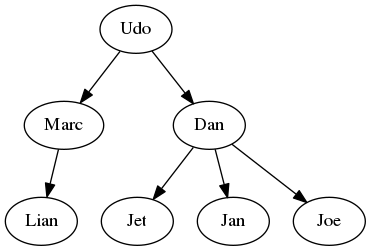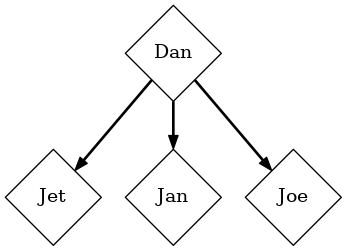Any Python Tree Data¶






Simple, lightweight and extensible Tree data structure.
Feel free to share info about your anytree project.
Links¶
If you enjoy anytree

Feel free to share info about your anytree project.
Getting started¶
Usage is simple.
Construction
>>> from anytree import Node, RenderTree
>>> udo = Node("Udo")
>>> marc = Node("Marc", parent=udo)
>>> lian = Node("Lian", parent=marc)
>>> dan = Node("Dan", parent=udo)
>>> jet = Node("Jet", parent=dan)
>>> jan = Node("Jan", parent=dan)
>>> joe = Node("Joe", parent=dan)
Node
>>> print(udo)
Node('/Udo')
>>> print(joe)
Node('/Udo/Dan/Joe')
Tree
>>> for pre, fill, node in RenderTree(udo):
... print("%s%s" % (pre, node.name))
Udo
├── Marc
│ └── Lian
└── Dan
├── Jet
├── Jan
└── Joe
For details see Node and RenderTree.
Visualization
>>> from anytree.exporter import UniqueDotExporter
>>> # graphviz needs to be installed for the next line!
>>> UniqueDotExporter(udo).to_picture("udo.png")

The UniqueDotExporter can be started at any node and has various formatting hookups:
>>> UniqueDotExporter(dan,
... nodeattrfunc=lambda node: "fixedsize=true, width=1, height=1, shape=diamond",
... edgeattrfunc=lambda parent, child: "style=bold"
... ).to_picture("dan.png")

Manipulation
A second tree:
>>> mary = Node("Mary")
>>> urs = Node("Urs", parent=mary)
>>> chris = Node("Chris", parent=mary)
>>> marta = Node("Marta", parent=mary)
>>> print(RenderTree(mary))
Node('/Mary')
├── Node('/Mary/Urs')
├── Node('/Mary/Chris')
└── Node('/Mary/Marta')
Append:
>>> udo.parent = mary
>>> print(RenderTree(mary))
Node('/Mary')
├── Node('/Mary/Urs')
├── Node('/Mary/Chris')
├── Node('/Mary/Marta')
└── Node('/Mary/Udo')
├── Node('/Mary/Udo/Marc')
│ └── Node('/Mary/Udo/Marc/Lian')
└── Node('/Mary/Udo/Dan')
├── Node('/Mary/Udo/Dan/Jet')
├── Node('/Mary/Udo/Dan/Jan')
└── Node('/Mary/Udo/Dan/Joe')
Subtree rendering:
>>> print(RenderTree(marc))
Node('/Mary/Udo/Marc')
└── Node('/Mary/Udo/Marc/Lian')
Cut:
>>> dan.parent = None
>>> print(RenderTree(dan))
Node('/Dan')
├── Node('/Dan/Jet')
├── Node('/Dan/Jan')
└── Node('/Dan/Joe')
Extending any python class to become a tree node
The enitre tree magic is encapsulated by NodeMixin,
add it as base class and the class becomes a tree node:
>>> from anytree import NodeMixin, RenderTree
>>> class MyBaseClass(object): # Just an example of a base class
... foo = 4
>>> class MyClass(MyBaseClass, NodeMixin): # Add Node feature
... def __init__(self, name, length, width, parent=None, children=None):
... super(MyClass, self).__init__()
... self.name = name
... self.length = length
... self.width = width
... self.parent = parent
... if children: # set children only if given
... self.children = children
Just set the parent attribute to reflect the tree relation:
>>> my0 = MyClass('my0', 0, 0)
>>> my1 = MyClass('my1', 1, 0, parent=my0)
>>> my2 = MyClass('my2', 0, 2, parent=my0)
>>> for pre, fill, node in RenderTree(my0):
... treestr = u"%s%s" % (pre, node.name)
... print(treestr.ljust(8), node.length, node.width)
my0 0 0
├── my1 1 0
└── my2 0 2
The children can be used likewise:
>>> my0 = MyClass('my0', 0, 0, children=[
... MyClass('my1', 1, 0),
... MyClass('my2', 0, 2),
... ])
>>> for pre, fill, node in RenderTree(my0):
... treestr = u"%s%s" % (pre, node.name)
... print(treestr.ljust(8), node.length, node.width)
my0 0 0
├── my1 1 0
└── my2 0 2